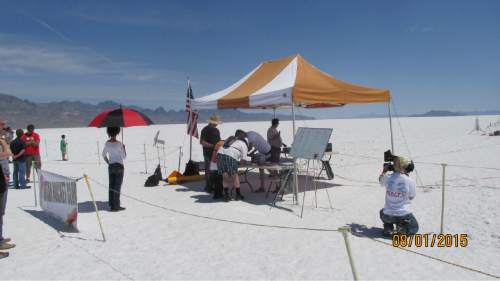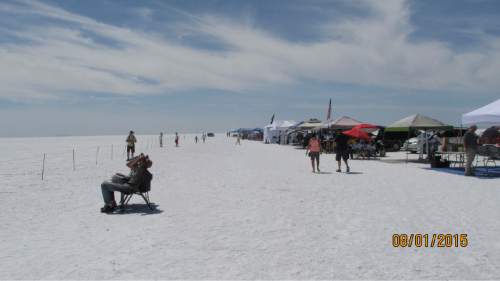This is an archived article that was published on sltrib.com in 2015, and information in the article may be outdated. It is provided only for personal research purposes and may not be reprinted.
The Utah Rocket Club celebrated its 20th-annual HellFire launch over the weekend. As we do most years, Sonny and I drove out to a remote area north of Wendover to watch stuff blow up.
Note: Because of last year's misunderstanding with the BLM about shooting holes in the salt with a bowling-ball cannon, Sonny's wife came along to make sure we behaved.
On Saturday, the weather for HellFire's 20th "Sun, Salt, and Rockets" was perfect. Meteorologists don't always get it right, but whoever predicted "clear, warm, with a 100 percent chance of $#*% falling out of the sky" nailed it perfectly.
HellFire launches are great. Once a year, the nicest bunch of crazy people you would ever want to meet gather in a place no one in their right mind would go on purpose and tempt their fates by ripping holes in the sky.
Given the nature of the endeavor, HellFire launches are held out on the Bonneville Salt Flats, where it's almost impossible to hurt anyone — should something go horribly amiss — who didn't want to be there in the first place.
A word of caution: The Salt Flats is not a pleasant place to be, particularly in August. In addition to being hot, waterless and flatter than roadkill, out there, the sun shines not only down, but also up.
Salt-flat salt isn't like table or rock salt. It's greasy, sticky and murderously reflective. It will bounce the sunlight back up the insides of your nose and the legs of your shorts.
It's not unheard of for novice HellFire attendees to go home and have to explain to an angry significant other why their nether regions got blistered.
But Sonny and I are pleased to report that — as usual — nobody was seriously injured at Saturday's launch. This lack of human drama notwithstanding, the event was fun and interesting.
Rockets launched Saturday ranged in size from small pig whistles all the way up to serious 18-foot monsters the diameter of an oil drum. Depending on the motor, they will zip hundreds of feet into the air, or thunder almost into the stratosphere.
Mechanical things don't always go according to plan. That's because all mechanical stuff requires an important component known as "somebody."
For example, "somebody" put the rocket engine backwards, or "somebody" forgot to lock the launch rail in the upright position, or "somebody" made my rocket launch sideways.
For those who hadn't spent thousands of dollars and hours building a rocket for the big day, this could be the most entertaining part.
While it is fun to see a rocket go from the launch pad to completely out of sight in less than three seconds, it's even more enjoyable to watch a large one come back down at full speed because the parachute failed.
Speaking of which, the most memorable mission failure Saturday occurred while two guys were gingerly loading a rocket the size of an elephant leg onto the launch rail.
A number of us gathered close to watch. At that moment, there was a loud mechanical burp. The parachute popped out and settled over everyone.
Exactly why the rest of the rocket failed to detonate is a matter several of us mulled over while sprinting for the portable toilets.
This year's HellFire launch was every bit as enjoyable as the others we've attended. If nothing else, it impressed on me the need to stick to cannons.









